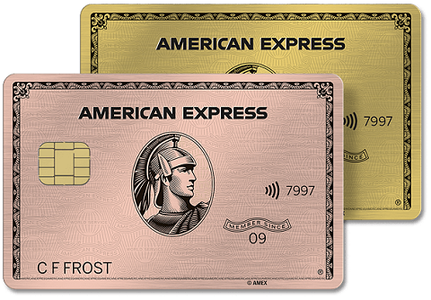Why you might want to get the Sapphire Preferred
The most obvious advantage the Chase Sapphire Preferred® Card has over the Amex Gold is its annual fee — over $150 less. The Chase Sapphire Preferred is better for people looking to earn and redeem travel-specific rewards. Its perks are primarily travel-related, its highest reward category is travel, and its points are worth the most when redeemed for travel. It’s not our top choice for super frequent travelers, but for the average, casual traveler, the Sapphire Preferred is one of our favorite choices.
Bottom line: The Chase Sapphire Preferred is best for casual to semi-frequent travelers who want to earn and redeem points primarily on travel.
Why you might want to get the Amex Gold instead
The American Express® Gold Card is a top-tier option for people who enjoy dining out. It has travel-related benefits, but the bulk of its value comes from its statement credits— up to $120 annually for eligible dining purchases (enrollment required) and up to $120 in Uber Cash per year. Additionally, the Amex Gold card’s highest reward category is restaurants, earning 4X Membership Rewards points.
Bottom line: The Gold Card from American Express is primarily for people who spend a lot of money at restaurants (and takeout or delivery in the U.S.).
Should you get both the Sapphire Preferred and the Amex Gold?
It could make sense to get both cards if you like to travel and dine out.
The Amex Gold can do most of the heavy lifting of earning points at restaurants and U.S. supermarkets, and you can take advantage of its valuable statement credits and partner benefits. If utilized, these credits can easily offset the annual fee.
Concurrently, you can use the Chase Sapphire Preferred to earn and redeem points on travel purchases and take advantage of its very different statement credits and partner benefits.
We wouldn’t necessarily recommend applying for both at the same time, however, as that would reduce your chances of spending enough on each to earn their respective welcome bonuses.
Chase Sapphire Preferred vs. Amex Gold: Welcome bonus
Winner in this category: American Express® Gold Card
Sapphire Preferred: The Chase Sapphire Preferred comes with a welcome bonus of 75,000 points if you spend $4,000 within your first three months of card membership. This equates to over $900 in value if you choose to redeem your points for travel.
Amex Gold: The Amex Gold Card lets you earn 60,000 Membership Rewards® Points if you spend $6,000 within six months of opening an account. This is worth up to approximately $1,200, depending on how you redeem your points.
Amex Gold has a slight edge here since you have to spend an average of $1,000 per month to earn the bonus. Since Chase only gives you three months to qualify, you’d have to spend a little over $1,333 per month to reach the spending threshold.
Chase Sapphire Preferred vs. Amex Gold: Rewards
Winner in this category: American Express® Gold Card
When comparing the Amex Gold Card vs. Chase Sapphire Preferred, the Gold Card comes out ahead in terms of earning and redeeming rewards.
However, the best fit for your needs depends on how much you spend in each category. In some circumstances, the Chase Sapphire Preferred outperforms the Gold Card from American Express.
Which is better for earning rewards?
Winner: It depends
In terms of earning rewards, the right card for you depends on how you spend your money.
For example, the Chase Sapphire Preferred gives you:
-
5X points on travel purchased through Chase Travel℠
-
5X points on Lyft rides (through March 31, 2025)
-
3X on dining, select streaming services, and eligible online grocery purchases
-
2X on non-Chase travel
-
1X on everything else
In contrast, the Amex Gold gives you:
-
4X points at restaurants (plus takeout and delivery in the U.S.)
-
4X points at U.S. supermarkets (on up to $25,000 per year, then 1X)
-
3X points on flights booked directly or with American Express Travel
-
1X points on all other eligible purchases
For travel, if you don’t mind booking through Chase Travel℠ , the Sapphire Preferred is the better bet.
The Amex Gold is slightly better if you’re more interested in earning points on grocery and dining purchases.
Which is better for redeeming rewards?
Winner: American Express® Gold Card
Both rewards credit cards give you multiple redemption options, but the Amex Gold gives you more flexibility, making it the winner in this category.
Chase Sapphire Preferred: If you get the Sapphire Preferred, the best way to redeem your points is to use Chase Travel℠ to pay for travel purchases. You can also purchase gift cards, redeem your points at participating partner websites or transfer your points to an airline or hotel loyalty program. Chase has 11 partner airlines and three partner hotel brands.
The Amex Gold gives you the following redemption options:
- Pay with Points at checkout when you use PayPal or one of 14 additional participating merchants.
- Redeem your points for a statement credit equivalent to one or more of your previous purchases.
- Use your points to buy gift cards.
- Book Reward Travel or upgrade your existing travel arrangements.
- Use the Membership Rewards portal to shop with participating partners.
- Transfer your points to a participating airline or hotel loyalty program.
American Express has 13 partner airlines and three partner hotel brands.
Chase Sapphire Preferred vs. Amex Gold: Benefits
Winner in this category: American Express® Gold Card
If you’re comparing Amex Gold vs. Chase Sapphire Preferred in terms of non-travel benefits, the Amex Gold wins again.
Dining credits
Winner: American Express® Gold Card
In terms of dining credits, Amex Gold offers much more than the Sapphire Preferred.
Amex Gold comes with the following benefits:
-
Uber Cash: The Amex Gold gives you up to $10 in Uber Cash each month when you use your card to pay for Uber rides or Uber Eats orders. You can use Uber Cash to order takeout, increasing the total value of your dining benefits.
-
Dining credit: If you use the Amex Gold at Wine.com, Goldbelly, Grubhub, Milk Bar, The Cheesecake Factory or select Shake Shack locations, you’ll earn up to $10 per month in dining credits. Enrollment required.
Sapphire: Chase Sapphire Preferred comes with a 1-year DashPass subscription, which entitles you to reduced service fees and $0 delivery fees on eligible DoorDash orders. However, it doesn’t offer any statement credits based on your dining purchases.
Travel insurance
Winner: Chase Sapphire Preferred® Card
The Amex Gold and Chase Sapphire Preferred both offer comprehensive travel insurance.
The Sapphire Preferred card comes with the following Chase Sapphire travel insurance benefits:
- Trip cancellation and interruption coverage
- Auto rental collision damage waiver
- Trip delay reimbursement
- Travel and emergency assistance
- Lost luggage reimbursement
- Baggage delay insurance
- Travel accident coverage
Amex Gold: Gold gives you access to baggage insurance, car rental loss and damage insurance, trip cancellation/interruption coverage, trip delay insurance and travel assistance benefits.*
Therefore, these are two of the best credit cards available if you’re looking for extra travel protection.
*Eligibility and Benefit level varies by Card. Terms, Conditions, and Limitations Apply. Please visit americanexpress.com/benefitsguide for more details. Underwritten by Amex Assurance Company.
Special offers
Winner: American Express® Gold Card
Both Chase and American Express give cardholders access to special offers, but Amex has a much bigger list of partners.
Sapphire: With the Sapphire Preferred, you get 5X points on eligible Peloton purchases, a six-month subscription to Instacart+, up to $15 in Instacart statement credits per quarter until July 2024 and 5X total points on Lyft rides completed through March 2025.
Gold: If you get the Amex Gold, American Express will display current offers in your online account. These offers change regularly, so pay close attention to the expiration dates. If you add an offer to your card and redeem it before it expires, you’ll earn cash back or extra rewards. Amex has offers available from Hello Fresh, Office Depot, Bose, Stitch Fix and more.
Hotel credits
Winner: Chase Sapphire Preferred® Card, since its credit is more flexible
Gold: With the Amex Gold Card, you can get a $100 experience credit when you book The Hotel Collection through American Express Travel (2-night minimum stay required, Experience credit varies by property).
Sapphire: The Chase Sapphire Preferred allows you to earn up to $50 in statement credits per year for hotel stays booked through Chase Travel℠.
Chase Sapphire Preferred vs. Amex Gold: Fees
Winner in this category: Chase Sapphire Preferred® Card
The Chase Sapphire Preferred Card comes out ahead in this category due to its significantly lower annual fee ($95, vs. Amex Gold’s $250). Additionally, the Sapphire Preferred allows for balance transfers while the Amex Gold doesn’t. Neither card has foreign transaction fees.
(see Amex Gold rates and fees)
Chase Sapphire Preferred vs. Amex Gold: Eligibility
Winner in this category: It’s a tie!
Chase and American Express have similar eligibility requirements for these cards. You need to have a credit score in the good or excellent range. A good FICO® score ranges from 670 to 739, so you should have at least a 670 before you apply for either card.
Note that your credit score isn’t the only factor used to determine if you qualify. For example, you may have a FICO score of 810, but you’re not likely to be approved if you don’t have a steady source of income.
Chase also has an unofficial policy known as the 5/24 rule. If you’ve opened five or more personal credit cards in 24 months, Chase may deny your Sapphire Preferred application even if you have perfect credit and plenty of income. Therefore, the Amex Gold may be a better fit if you’ve opened several credit cards within the past 2 years.
Bottom line: Should I get the Chase Sapphire Preferred or Amex Gold?
The bottom line is that the right card for you depends on your spending habits. If you want to maximize your travel benefits without paying a high fee, the Chase Sapphire Preferred® Card is probably your best bet. The American Express® Gold Card is a better fit if you spend a lot on dining and want to maximize your partner benefits and statement credits.
If you’re willing to book travel through the Chase Travel℠ portal, then the Sapphire Preferred has a slight edge over the Amex Gold. You’ll earn 5X back on eligible travel purchases instead of 3X on flights.
Terms apply to American Express benefits and offers. Enrollment may be required for select American Express benefits and offers. Visit americanexpress.com to learn more.































































































































